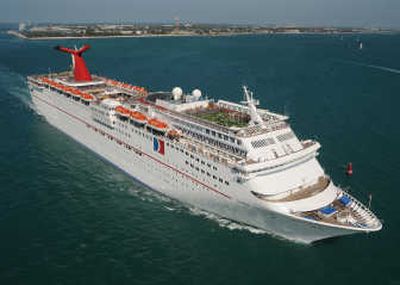Port proposal riles cruise business

Americans who take ocean cruises could face dramatic changes in their itineraries under proposed new federal customs regulations.
Most cruise liners would be required to stay 48 hours at foreign ports, instead of the token visits that are used now to meet the existing law. The change might not play well with travelers who prefer frequent stops at a variety of places.
Also, many popular cruise routes would have to be reconfigured. For example, Caribbean cruises from New York and New Jersey might have to eliminate some popular stops, while Alaska-bound cruises may drop Seattle as their starting port and switch to Vancouver.
Critics of the proposal say the changes would devastate the cruise industry, cost thousands of jobs and imperil ports that depend on the travel trade.
“The proposal would cause immediate, significant economic harm to the U.S. port industry,” said Kurt Nagle, president of the American Association of Port Authorities.
“I wouldn’t like it,” said Terrance Purdy, of Hardyston, N.J., who was about to start a nine-day trip to the Caribbean last Friday at the Cape Liberty Cruise Port in Bayonne, N.J. “When you take a cruise, you like to be able to see a lot of different islands.”
Maritime officials, however, insist that cruise regulations need to be changed to prevent foreign-flagged ships from gaining an unfair advantage over American vessels.
The proposed revisions in customs regulations stem from a Pacific Ocean tempest involving a 19th-century law and the cruise lines that serve Hawaii.
The Passenger Vessel Services Act of 1886 was a stroke of protectionism designed to give American merchant ships a monopoly on U.S. coastline trade, including passenger travel, by putting restrictions on foreign carriers. Under the law, foreign-flagged carriers were prohibited from carrying passengers between American ports without first stopping at a foreign terminal.
Now, fast-forward to the 21st century.
In recent years, American-flagged cruise ship companies began complaining that foreign competitors were making a mockery of the 19th-century law by running ocean liners between California and Hawaii that stopped only for an hour in Mexico – which authorities considered an “evasion” of the requirement for a foreign port visit.
The U.S. Maritime Administration, which promotes the American-flagged ship industry, asked Customs and Border Protection to craft rules to prevent such maneuvers.
“They were stopping at 2 a.m. at Encinada and leaving at 3 a.m.,” said U.S. Maritime Administrator Sean Connaughton. “It was right on their Web site. It said it was only a service call and no passengers could get off the ship there.”
But because the current regulations do not stipulate how long a ship must stop at a foreign port, the only way to prevent the practice was to draw up more specific rules, Connaughton said.
The agency came up with a proposal that included three new requirements on foreign carriers, including:
•The stop at a foreign port last at least 48 hours.
•The total time spent at foreign ports be at least half the total time spent at U.S. ports on the cruise.
•Passengers must be allowed to go ashore during the stop at the foreign port.
Last year, customs officials asked for public comments on the proposal. They were deluged with more than 1,000 submissions. Those included letters from the ports group, the U.S. Chamber of Commerce and the Cruise Lines International Association – all of which are strongly opposed to the changes.
The ports group said the new policies would severely hurt the cruise terminals in New York Harbor and jeopardize the $200 million that New York City officials are investing in cruise ports in Manhattan and Brooklyn.
Last year, 1,060,837 passengers took cruises on 256 ships from the two New York terminals. Meanwhile, the Bayonne terminal handled 278,000 passengers last year, said Anthony Caputo, director of Cape Liberty Cruise Port.
The new regulations would affect only foreign-flagged cruise ships, but that accounts for the vast majority of them, according to authorities. The Cruise Lines International Association, which says it represents about 97 percent of the cruise industry in this country, says that only five of its members’ 175 ocean-going cruise ships fly under the American flag.
Running a U.S.-flagged cruise ship tends not to be as profitable as operating one under a foreign flag, officials said. That’s because U.S. ships face a host of hurdles – including taxes, labor issues and safety inspections – that don’t apply to foreign-flagged cruise liners, said Glen Vereb, the customs chief overseeing the cruise industry.
Vereb said it may take weeks or months before officials decide whether to adopt the proposals, scrap them or modify them.
“The beautiful thing about a proposal is that it’s very possible that it could come down,” he said.